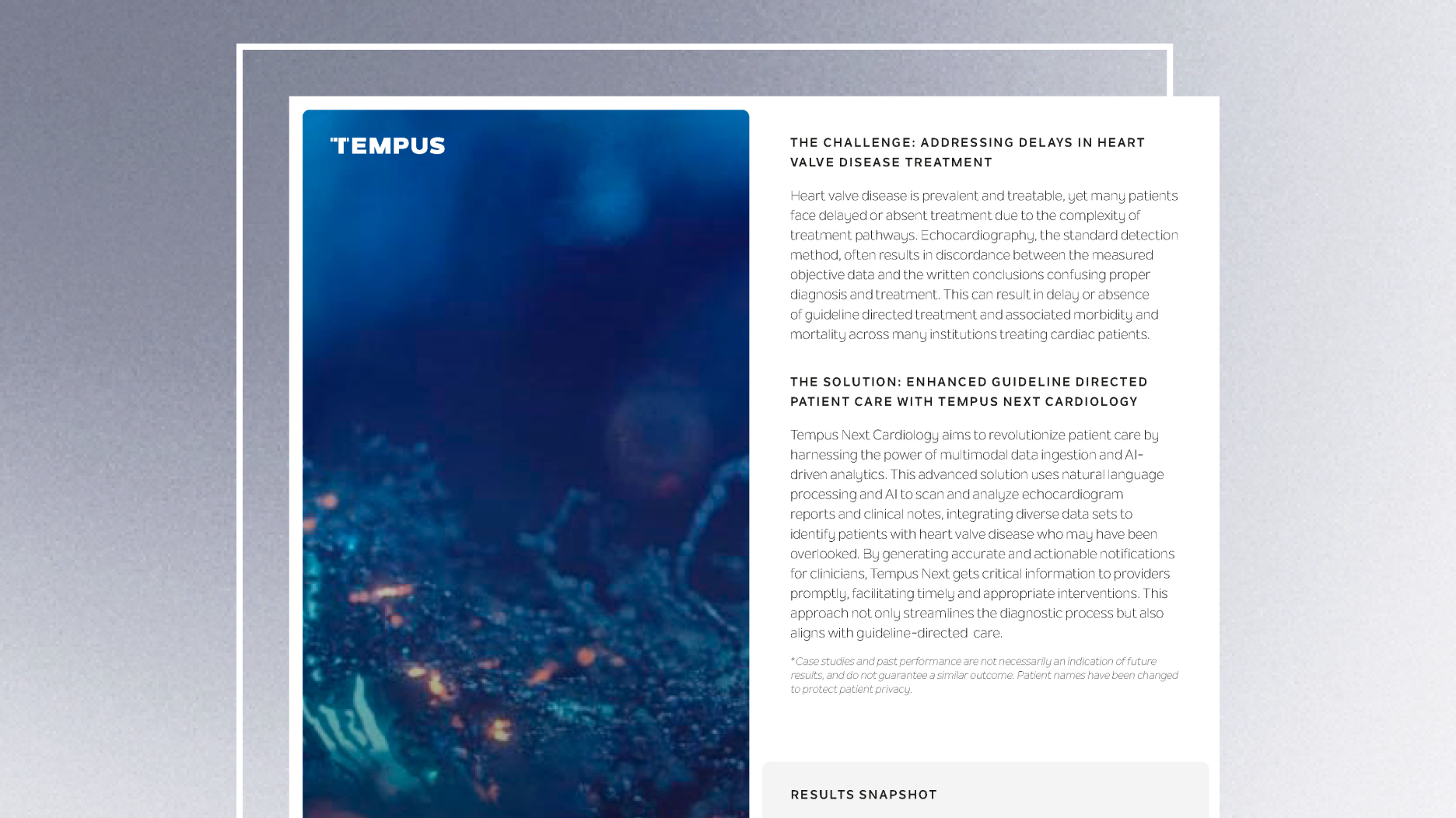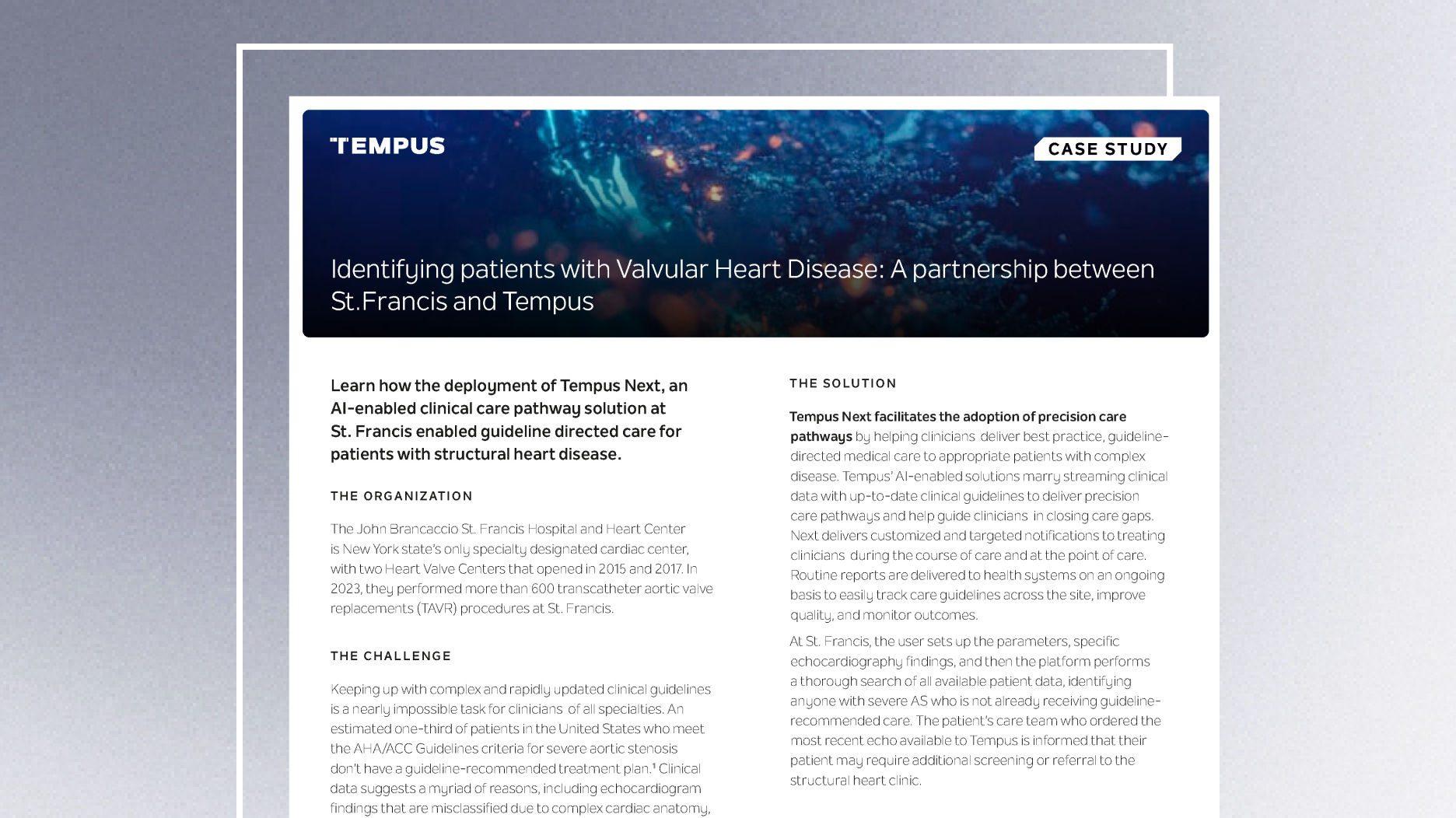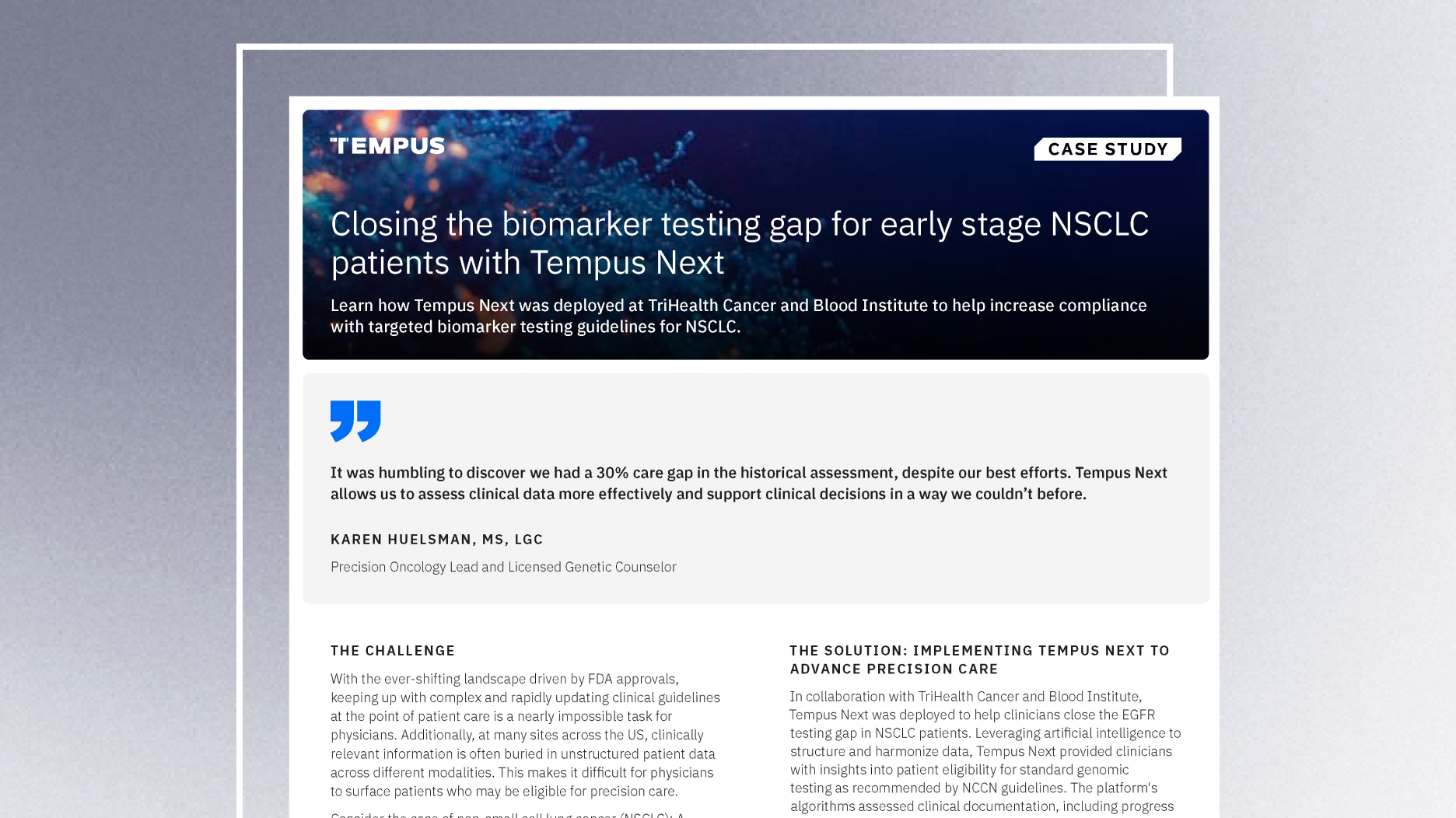-
PROVIDERS
REGISTER NOW
Navigating new frontiers in breast cancer care pathway intelligence: The role of providers and AI
Tuesday, July 29th
2:00pm PT, 4:00pm CT, 5:00pm ET -
LIFE SCIENCES
REGISTER NOW
Closing Care Gaps with AI: The Next Competitive Edge in Pharma
Monday, July 14
9am PT, 11am CT, 12pm ET -
PATIENTS
It's About Time
View the Tempus vision.
- RESOURCES
-
ABOUT US
View Job Postings
We’re looking for people who can change the world.
- INVESTORS
07/13/2023
Q&A: The evolution of RWE & HEOR—A conversation with two biopharmaceutical executives
Dr. Gupta and Dr. Iyer discuss the evolution of RWD in HEOR with Dr. Sasser.
Authors
Dr. Kate Sasser
Chief Scientific Officer, Tempus

Sanjay Gupta, PhD, MBA
Vice President, Head of Worldwide RWE and U.S. HEOR, DHBL

Shrividya Iyer, PhD
Executive Director, Oncology Worldwide RWE and U.S. HEOR

Chief Scientific Officer, Tempus
Sanjay Gupta, PhD, MBA
Vice President, Head of Worldwide RWE and U.S. HEOR, DHBL
Shrividya Iyer, PhD
Executive Director, Oncology Worldwide RWE and U.S. HEOR
Within health economics and outcomes research (HEOR), real-world data (RWD), and real-world evidence (RWE) are key levers to better understanding patient populations. As the field has evolved, life sciences leaders have considered ways to design more rigorous RWE studies that enable more comprehensive evidence strategies and submission packages. Dr. Kate Sasser, Chief Scientific Officer at Tempus, recently sat down with two RWE and HEOR leaders from Eisai to discuss opportunities and challenges associated with using multimodal data in their oncology efforts. Read on to learn more from Sanjay Gupta, PhD, MBA, Vice President, Head of Worldwide RWE and U.S. HEOR, DHBL; and Shrividya Iyer, PhD, Executive Director, Oncology Worldwide RWE and U.S. HEOR.
Responses have been edited for clarity and length. The comments below reflect the views of the interviewees only, not of Eisai as an organization.
Dr. Sasser: Thanks for taking the time to speak with me today. To start, can you please introduce yourselves and your current roles?
|
|
Dr. Gupta: I’m Dr. Sanjay Gupta, and I lead the worldwide RWE and US HEOR team at Eisai. I’ve been with the company for over four years, and I’ve been in the pharma industry for almost 28 years. |
|
Dr. Iyer: I’m Dr. Shri Iyer, and I’m the Executive Director of Oncology Worldwide RWE and US HEOR at Eisai. My team is responsible for RWE and HEOR across tumors and products, as well as economic analyses in the US market for our launch indications. I have been in the oncology space for nearly 20 years. I have a PhD in outcomes research, and before Eisai I worked in Pfizer’s oncology business unit. I joined Eisai to help build its RWE and HEOR team across numerous indications and oncology pipeline prospects. |
Dr. Sasser How has RWD and HEOR evolved over time, both within Eisai and in the industry?
|
|
Dr. Gupta: Over the course of my time in the industry, I’ve found that the field of RWE and HEOR is constantly evolving; its structure and the role it plays varies from organization to organization. Early in my career, RWE and HEOR were seen as U.S. focused functions. We would generate evidence on products on the market to address the needs of U.S. payers. Over the years, the field has changed dramatically. We now generate evidence for guideline developers, health policymakers, and healthcare providers (HCPs), in addition to payers. Using RWD and health economics data, we’ve also helped update government policies on their coverage decisions. For example, I worked on one product that was not covered for the Medicare patient population, but using RWD we were able to get the policy updated. More recently, regulators have paid increased attention to RWD. Because the utilization of RWE and HEOR has expanded – from pre-clinical through early stage development, late-stage development, and commercialization – we’ve seen internal evolution within pharma companies in addition to external changes. Today, some organizations structure RWE and HEOR teams within medical affairs, while others sit in commercial. |
Dr. Sasser: What challenges have you seen relating to the use of RWD and RWE?
|
|
Dr. Gupta: Perceptions on RWE have evolved from regulators’ and healthcare providers’ points of view. While the gold standard for evidence continues to be randomized clinical trials (RCTs), no study is perfect, and all clinical trials come with limitations. Therefore, we see RWD being utilized as an adjunct to RCT data. In terms of challenges, HCPs initially pushed back on the use of RWD because of the lack of understanding and training, and also because of the dubious quality of some studies. At Eisai, we do everything we can to make the design and methodology of real-world studies as rigorous as possible. As a result of these higher quality studies, plus our RWE education efforts, we’re seeing more openness among stakeholders, including regulators. |
Dr. Sasser: How does RWD fit into your broader HEOR strategy? What needs to be done on an industry level to move RWE and HEOR initiatives forward?
|
|
Dr. Iyer: RWD is a data source that can help us study the same outcomes in clinical trials as an extension to an evidence strategy. But it’s important to remember that strategy has to be customized to each trial; we can’t use the same approach in one trial just because it worked in another. We must be thoughtful and constantly refine our strategies, because they can become outdated quickly – especially in oncology, which is a fast-moving space. We can use RWD to understand how to define unmet need in early phases or to analyze economic outcomes later on. For certain tumors, patient-reported outcomes become key to understanding and assessing symptoms. To me, what’s especially interesting is the applications of RWE and HEOR beyond the pharma industry. We’re trying to impact a broader health ecosystem, so while we can certainly use RWD in industry, we can also use it for public health purposes to understand population-level trends and how to improve them. But for any system to work, it needs to be sustainable. If we’re creating an innovative data ecosystem, we need to create a feedback loop to make it trustworthy. It needs to be rigorous, especially as we continue to work on data quality in oncology. I’m optimistic that technology can help in this process to communicate that evidence is on a continuum, and RWE in addition to RCTs can help us be more efficient. We also need more standardization. There are some data points that are critical for certain diseases, tumors, products, or patient populations, so it’s critical that we collaborate with technology companies and HCPs to set clear goals for evidence in our ecosystem. |
|
Dr. Gupta: I’d also like to add that RWE is a component of HEOR, alongside the economic modeling and humanistic outcomes components. We’ve found that payers in the U.S. are apprehensive about economic models informed by RWD from industry, so we need to develop models together with them. Once we demonstrate that a study is rigorous and have RWE published in prestigious journals, we can add more credibility to our work and build trust. |
Dr. Sasser: How do you calculate the return on investment of using RWD in HEOR?
|
|
Dr. Gupta: There are many ways to calculate ROI. About a decade ago, companies valued getting the patient perspective into the product label via negotiations for regulators; that represented a real ROI. Today, publications also support ROI, as the industry uses the quality of publications and their impact on the field as a key metric. We may also assess customer perceptions when our field team presents RWE, or responses to particularly strong data shared in a press release. Sometimes we look at how data generated in on-label populations can influence HCP activity. But generally, our job is to generate quality scientific data that resonates with our stakeholders. |
Dr. Sasser: How do you utilize multimodal data in HEOR, and which aspects of the multimodal description do you find most useful for your applications?
|
|
Dr. Iyer: In oncology, we use multimodal data to keep patients at the core of our work and build population-level metrics. At the patient level, you need genomic data, baseline information, lab values, and some metrics on resource utilization, especially when symptoms are a key focus for the indication. While not every piece of information is relevant to every indication or tumor, we can use multimodal data to learn more about the patient, from the patient. This helps to build a comprehensive data structure from which we can design an appropriate strategy for your stakeholder. I think of a multimodal data strategy like a piece of classical music: you can’t leave any instrument out, but you should customize when and how you use each one to best serve your audience. |
|
Dr. Gupta: Especially in the U.S. where healthcare is so fragmented, all stakeholders look at the data from their own perspective. This makes a few key components especially valuable: real-time data, integrated data from different systems and sources, and completeness. With regard to completeness, some data sources may not have all of the variables we need. It’s important to have a firm understanding of what data elements are missing and work to mitigate the issue so as not to put a study’s credibility in question. |
Dr. Sasser: Let’s talk more about Eisai and Tempus’s collaboration. How are we using RWD to benefit and advance Eisai programs, and what challenges have you run into?
|
|
Dr. Gupta: The reason we identify Tempus as the best data source is because Tempus datasets are strong when it comes to the integration of genomic data with patients’ clinical and demographic data. While it may not be the best option for every study – we have faced challenges with missingness and generalizability of genomic information to broader populations – the Tempus dataset has brought significant value, especially in pre-approval studies. |
|
Dr. Iyer: Generalizability is a challenge in genomic data because the starting point is sequencing: a portion of the population is sequenced, and a portion is not. But it can be very useful in disease-level studies. In one of our projects, we’ve found Tempus’s data helpful to understanding how many patients fail on current therapies or have a certain mutation or receptor level in a population that doesn’t yet have a targeted therapy. This is much more useful to clinical development than relying on the most recent publications , which could bring down the probability of success especially in a new targeted population. To help address unmet need, we need to understand why the current treatments aren’t working and whether there are alternatives for those patients, then build a comparator arm that reflects the current population. Tempus’s multimodal data can help with this. |
Dr. Sasser: Where do you see RWD and HEOR going as a field in the next five years? What do you hope the field will have achieved by then?
|
|
Dr. Gupta: I hope to start seeing more regulatory submission packages that contain RWD to support RCT data. We won’t see a full change in five years, but we can begin to see prospective RWD collection add value alongside a clinical trial or to support a label expansion. The FDA has been working on this in the U.S., as has the EMA in Europe, so I hope we have clear guidance for industry in the coming years. I feel that HCPs who had been resistant to RWD are increasingly changing their position, because they recognize that RCTs have limitations. RCTs are based on patient populations who are more likely to respond to treatment, but because there are areas of high unmet need in the real world, these treatments will be used in other patient populations once they reach the market. RWD studies are significantly broader than the label population, and they can also reveal treatment pattern differences based on individual clinicians’ dosing considerations. On the whole, physicians are starting to understand that RWD can support them and they’re expressing heightened interest, and I expect to see this trend continue. |
|
Dr. Iyer: Given the AI revolution we’re currently going through, I expect to see AI becoming more incorporated into HEOR. Technology companies have a significant role to play in improving data quality. Once we have data in a more structured, curated format, it’ll be a lot easier to work with for HCPs and other stakeholders. In five years, I hope we get to a point in oncology where 100% of the patient data elements we need are structured and more automated with AI. Algorithms can analyze imaging data, for example, and physicians can decide whether to accept its conclusions on disease progression or not. This will help to make progression a structured variable. Ten years from now, I hope RWD usage and collection becomes as natural and real-time as our autopay systems, while of course maintaining patient privacy. Physicians and patients could get a ping saying their records have been updated as quickly as they can scan their phone to make a payment. |
-
06/25/2024
Revolutionizing Cardiac Care: AI-driven detection and treatment of critical heart valve disease at Boulder Community Health
Discover how Tempus Next's AI-powered care pathway platform transformed patient outcomes by helping ensure timely, guideline-directed treatment for critical heart valve disease at Boulder Community Health
Read more -
04/15/2024
Identifying patients with Valvular Heart Disease: A partnership between St.Francis and Tempus
Learn how the deployment of Tempus Next, an AI-enabled clinical care pathway solution at St. Francis enabled guideline directed care for patients with structural heart disease.
Read more -
04/15/2024
Closing the biomarker testing gap for early stage NSCLC patients with Tempus Next
Learn how Tempus Next was deployed at TriHealth Cancer and Blood Institute in Cincinnati, Ohio to surface and close gaps in biomarker testing for NSCLC patients.
Read more


